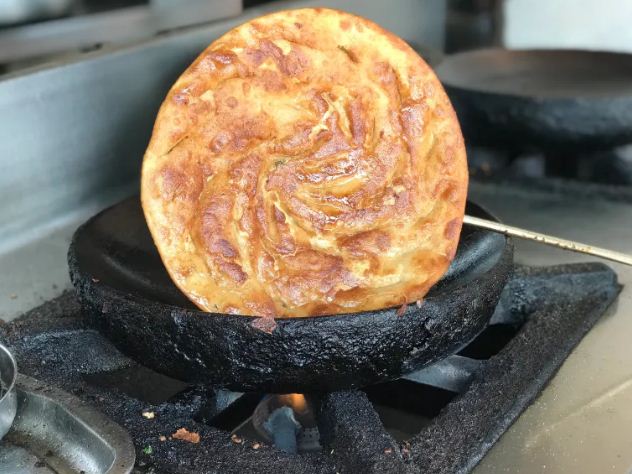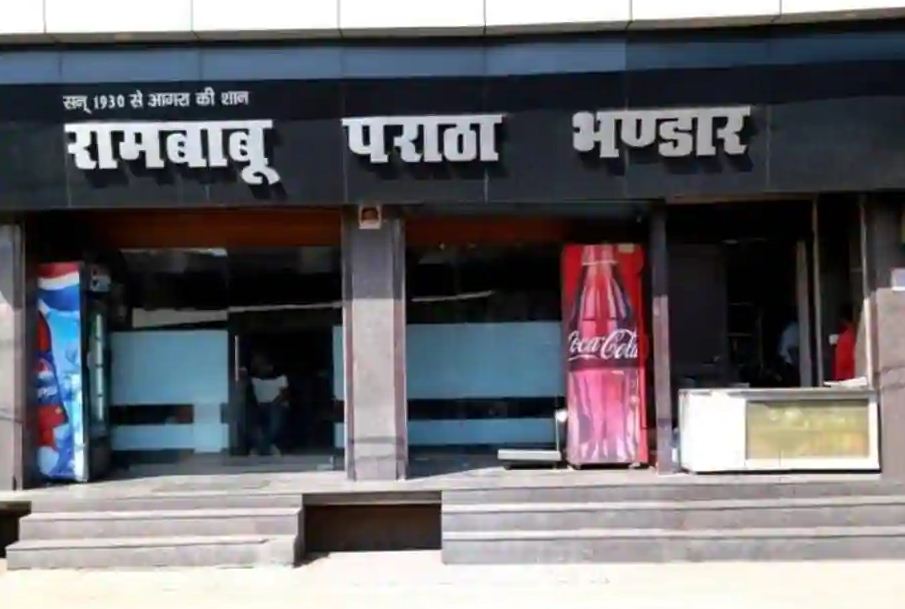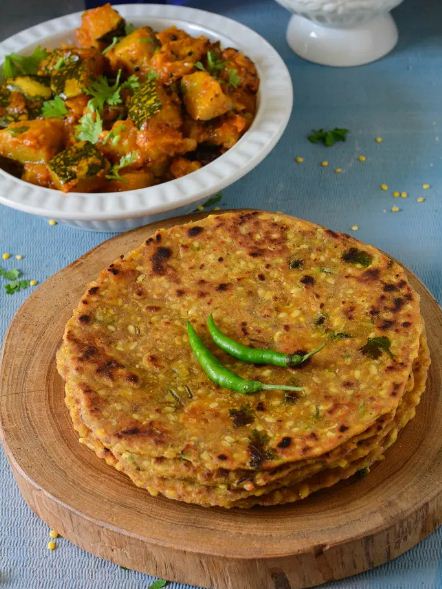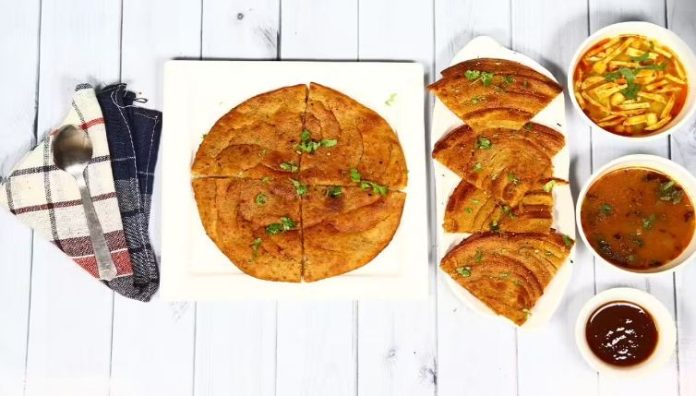By Foodie
Of the many special eateries that Agra boats of – many are centuries old, as old as the magnificent historical monuments around – one special shop stands out. The origin of the shop(s), known at one place (the earlier one) as Ram Babu Paratha Bhandar and the latter (near the Sikandra tomb) as Ram Babu Parathe Wale, dates back to 1930. The shops may have slightly different names, but the ownership is in the same family, and the renown is unmatched.
The USP of these shops is the ubiquitous paratha (stuffed Indian pancakes) and the varieties will make your head spin. This is a must visit eatery when you visit Agra next.
The culture and heritage of Agra is centuries old. From the magnificent monuments to being ruled by several dynasties with different ethnicities, the city is a fine blend of different cultures and traditions. This surely has impacted the food scene of the city.


If you are heading to the Taj Mahal or are planning to go there, then do make a stop at the local eateries and try the delicacies that the city has to offer. From pethas to dal moth, as we discover the taste of Agra, one of the things that you need to have is parathas from Ram Babu Paratha Bhandar (or Wale).
Though being a North Indian city, Agra enjoys a fine blend composition of several cuisines. One of the greatest joys that North Indian cuisine has offered is the delicious paratha. A paratha is a chapati (Indian pancake) that is stuffed with several ingredients, vegetables, and other elements to add taste to it.
Established in the year 1930, Ram Babu Paratha Bhandar in Belan Ganj, Agra is a top player in the category North Indian Restaurants in Agra. This well-known establishment acts as a one-stop destination servicing customers both local and from other parts of Agra. Over the course of its journey, this business has established a firm foothold in its industry. The belief that customer satisfaction is as important as their products and services, have helped this establishment garner a vast base of customers, which continues to grow by the day.
In Agra, this establishment occupies a prominent location in Belan Ganj. It is an effortless task in commuting to this establishment as there are various modes of transport readily available. It is at Belanganj Road, Belanganj Crossing, Near Yamuna Kinara Road, which makes it easy for first-time visitors in locating this establishment. It is known to provide top service in the following categories: Restaurants, North Indian Restaurants, Pure Veg Restaurants, Moderate Restaurants (Rs 500 to Rs 1,000).
Focused
The restaurant is very focused. It serves parathas of different kinds. The menu card is a long list of options.
The parathas were sliced into 4 like a pizza & served.
The parathas are cooked on a heavy & super thick iron tawa (more than 1 inch thick), & having the diameter of a paratha + 1 inch. The parathas were of course fried in ghee.


One had just to choose the paratha–sabzis were served with the parathas.
There are two branches in Agra
The restaurant has two branches in Agra city. One in Belanganj (Old) and the other (new), called Rambabu Paratha Wale, is located in Sikandra.
Ingredients
(Rambabu Paratha Thali)
- 1/2 Cup Wheat flour
- 2 small Boiled potatoes
- 1/2 cup Peas
- 1/2 tsp Pepper
- 1 tsp Chilli powder
- 1/2 tsp Cumin powder
- 1 tsp Coriander powder
- 1/2 tbsp Chopped ginger
- 1/2 tbsp Chopped green chillies
- to taste Salt
How to make
1. For the dough knead one cup of wheat and all-purpose together and let it rest for half an hour.
2. For stuffing take two potatoes, half cup of peas, chopped onions and shredded cauliflower.
3. Mix half tablespoon of pepper, chilli powder, cumin powder, coriander powder, chopped ginger, green chillies and salt according to taste.
4. Roll out your dough and fill the stuffing inside.
5. Shallow fry your parathas on the tawa till golden brown.
6. Now serve it with aloo ki sabzi, green chutney and kele ki chutney and enjoy.
PARATHAS FROM OTHER PLACES
Rajasthani Churi Ka Paratha or Moong Daal Paratha
Churi ka paratha or korme ka paratha is a specialty from Rajasthan. As Rajasthan happens to be a dry state so they use lots of gram flour, sun dried vegetables and lentils in their cuisine. They made so many types of delicious kadhi and curries with the use of gram flour and lentil or lentil flours.
Different varieties of parathas and poori’s are also made regularly using gram flour/besan, papad and lentils and served with curd and pickles. The lentil parathas are so healthy and delicious that there will be absolutely no need for any vegetables as side dishes.


These paratha’s taste great with just a cup of tea or with some pickles and chutney. These healthy Churi ka paratha can also be packed in kids tiffin boxes with some curd and chutney.
What is Churi Ka Paratha?
This lentil paratha is popular as churi /choori ka paratha or korme ka paratha. This is a very traditional recipe of Rajasthani cuisine.In olden days all the daals are crushed at home using the stone chakki. Whole gram and lentils are milled at home to make gram flour/besan, daliya and whole lentils are crushed to make split moong daal.
While doing so lots of semi crushed coarse dal powder is left which is called daal ka Korma/churi. This daal ki churi/korma is soaked in water and added in the flour to make paratha.
Ingredients
- 50 gm Yellow Lentil/Moong Daal
- 200 gm Wheat flour/ Multigrain atta
- 3 tbsp Cooking oil
- 2 tsp Fennel Seeds/ Saunf
- 2 tbsp Chili flakes/ Kuti lal Mirch
- 1/3 Asafoetida/Hing
- 2 tsp Whole Coriander/ Dhaniya Kuta Crushed
- 1/3 Turmeric/ Haldi
- Salt/ Namak
- 2 Green Chili/hari mirch
- 1/4 cup dhaniya
- Enough ghee or oil
How to make:
1. Wash and soak moong dal in enough water for 20 minutes.
OR
Soak moong daal ka korma in enough water for 15 minutes
2. Take a big wide bowl and add the soaked daal or korma ,wheat flour ,all the spices ,3 tbsp oil, chopped green chili and fresh coriander
3. Add water and make a medium soft dough , cover with a lid and let it rest for 15 minutes.
4. Make equal size balls from the dough and keep aside ,covered with a moist cloth.
5.Take a dough ball ,dust with dry flour and roll to make a thin chapati.
6. Heat a tawa /griddle and put the rolled paratha over it and dry roast from both the sides on medium heat.
7. Then apply some oil or ghee and roast from both sides by pressing with a spatula till nice golden in colour.
8. Remove from the tawa and serve hot.
9. Serving suggestion- serve with dahi ki aloo, aam ki launji or with any tangy pickle or chutney.
PUNJAB’S FAMOUS LACCHA PARATHA
Laccha paratha is a popular flatbread of Punjabi cuisine. It is said to have originated in the Indian sub-continent during the 12th century. The term ‘Laccha’ means ‘ring’. This paratha is made of layers of dough resting upon each other with each layer looking like a ring. The dough is frequently folded over while adding ghee to it, and frying it on a pan or in tandoor. Laccha paratha looks very similar to Malabar parotta; a flatbread popular in Kerala. Several techniques can be used to make this paratha.
The technique you use is very important, usually, there are two types of laccha paratha; a tawa laccha paratha and a tandoori laccha paratha. Tandoori style is the traditional way of cooking the paratha which gives it a dry and smoky texture. Whereas the tawa laccha paratha, though, tastes the same but has a more crumbly texture. Laccha paratha can be easily prepared at home. Here is how you can make the perfect laccha paratha.
Ingredients
- 2 cups whole wheat flour aka “atta” make sure it’s finely ground.
- 1/2 tsp salt
- 2 tbsp oil
- 1/2-3/4 warm water as needed
- ghee and flour as needed for layering
How to make
1. In a bowl, mix flour and salt.
2.Pour in oil and mix until flour becomes crumbly.
3.Next, slowly start adding warm water and bring the dough together until the flour is moistened. I typically end up using 1/2 to 3/4 cups of water but the quantity will depend on the temperature where you’re located.
4. Once flour is moist and you can pick it up in a ball, let it rest for 10-15 mins. The dough should just be a tad sticky to the touch. Dab on some oil so the surface does not dry out while the dough is resting. Resting will help the glutens in the dough to relax.
5. After 10-15 mins, start kneading the dough until it gets visibly soft. Add flour if it is too sticky. At the end of 3-4 minutes of kneading, the dough should be soft and it will bounce back when pressed with a finger gently.
6. Next, divide the dough in quarters for medium sized paratha (make sure the paratha is not bigger than your pan!) and shape each quarter in a round ball. At this point you can let the balls rest for another 10 mins. Don’t forget to apply oil so the top doesn’t dry out.
7. When ready to make paratha, roll out the dough very flat, as flat as you can. It’s okay if the dough rips a bit.
8. Next, smear ghee. I use my fingers to rub it all over the dough.
9. Next, sprinkle some flour along with salt. The flour prevents ghee from dripping, however, you can omit this since we only use a small quantity of ghee.
10. To make a flaky paratha, begin folding the dough from one corner like a Chinese fan and then twisting the dough up in a cinnamon roll shape. You can also make a slit from the center down to one end and begin rolling the dough from the slit in the shape of a cone and flatten it.
11. When you’re ready to make paratha, roll the layered ball of dough and with the help of a rolling pin, roll it out flat and round. It should not be too thin but enough so that you can easily pick up the paratha and flip from hand to hand without ripping it.
12. In a hot griddle, tawa or pan, plop down the paratha. Instantly, you’ll see the high heat begin to cook the paratha. When you see bubbles form on the surface, flip the paratha and lower the heat to medium. Apply some ghee and smear on the paratha with the back of a spoon.
13. Flip again, when you see brown spots appear on the underside.
14. Keep applying a touch of ghee and press down your spatula very gently. Lower the heat further if you think paratha is browning too fast.
15. Remove from the pan once paratha is speckled with brown spots. Don’t overcook, or else the paratha will get very crispy like a “papad.” You want to remove it when it’s nice and soft.
16. A tip to coaxing out the paratha layers (making it “lachedar”) is to scrunch it up while hot. Place your hands on either side of the paratha and clap them together, scrunching up the paratha. This will separate the layers. I recommend using kitchen paper or cloth to avoid burning your hands.
17. Serve hot! Paratha and roti are best enjoyed hot off the stove.





















